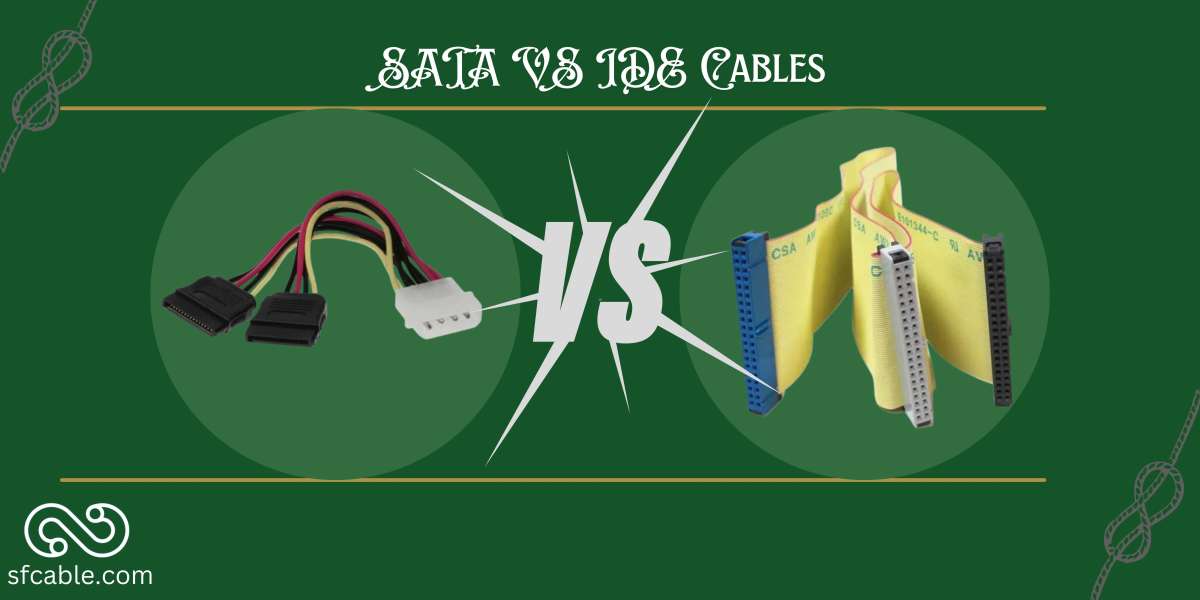In today's era of huge technological advancements, data transfer has become an important factor that needs to be primarily considered during any event. This data transfer is normally achieved with the use of cables such as SATA power cables and IDE cables. But then one may wonder: What makes both of these cables different from one another? That is why today we will go through the difference between SATA and IDE cables. We'll also discuss the points briefly and find out more information regarding these cables. So, without any delay, let's get going!
Differences Between SATA Cables and IDE Cables
There are many domains in which both of these cables differ. Here are some of the most prominent differences between SATA and IDE cables:
Overall Design
Coming to the first part, that is the look. Both cables can serve the same purpose, but the overall design of both of them varies largely.
SATA Cable
SATA power cables are more elastic than IDE cables. The connecting end consists of a small, seven-pin opening that joins with the device from which the data is to be transferred.
IDE Cable
IDE cables are way too different from SATA cables in terms of their look. They have less elasticity, and the connecting end has about 40–80 pins.
Cable Length
Cable length is another factor that can be used to differentiate between SATA Cables and IDE Cables.
SATA Cables
A SATA power connector is usually longer than an IDE cable. Their length can either be 39 inches or 78 inches. Shorter cables may have a lower reach but they are more efficient than the longer ones.
IDE Cables
IDE cables are normally shorter than SATA cables. It is about 18 inches in length. However, some extended IDE cables are available too.
Transfer Speed
This is a very important factor that can be used to study SATA vs. IDE cables. However, transfer speed is something that varies from brand to brand.
SATA Cables
SATA cables support faster data transfers than IDE cables. The speed also depends on the type of SATA cable. SATA I provides a speed of 1.5 Gbps, SATA II provides 3 Gbps, and SATA III provides a maximum speed of 6 Gbps.
IDE Cables
IDE cables provide comparatively slower data transfers. The speed of data transfer through these cables is about 133 Mbps.
Hot Swapping
Hot swapping refers to the disconnecting of cables without turning off the whole system. However, this feature varies from brand to brand too!
SATA Cables
SATA cables support the hot swapping feature and allow the user to disconnect the cable without turning off the computer.
IDE Cables
IDE Cables do not provide the facility of hot swapping. To disconnect the cable, one needs to turn off the computer.
Device Compatibility
With time, computer systems are upgrading at a fast pace, where a new model keeps replacing the last one. Because of this, device compatibility becomes a serious factor.
SATA Cables
SATA cables are mostly in synchronization with every type of newer computer system. They are highly versatile in their compatibility.
IDE Cables
IDE Cables has been in the industry for a very long time, and not much modification has been made to it since then. Therefore, the compatibility of these cables is a subject of question.
Importance of Choosing the Right Cable
Choosing the right cable is something that is very necessary to ensure the proper functioning and stability of both the cable and the computer system. Here are some of the major benefits of choosing the right cable:
Data Transfer Rate
Choosing the correct cable highly impacts the rate of data transfer. The correct wire will boost the speed to the maximum possible rate. Finding the correct wire is based on knowledge of the type of system. If one faces any issues, it is suggested to contact a professional.
Efficiency
The right cable will always enhance the efficiency of the work done. It will also maintain the health of the cable and the computer system as well. Choosing the right cable is very important for the proper functioning of heavy operations.
Data Corruption
Data corruption is a very common problem nowadays, which mostly happens through the transfer procedure. Choosing the right cable will guarantee smooth data movement without affecting the files.
Connection Adherence
Sometimes using the wrong cable can disrupt the data transfer and stop the movement. In such cases, either the files get corrupted or the file needs to be sent again from the very beginning. To avoid this issue, one must always choose the most compatible cable for their device.
Power Consumption
Another important factor that one should always keep in mind is that using the original and correct cable will always save power. Using random wires or the wrong wires will consume more power and eventually affect the computer's lifespan as well. It will also increase the bill. It is normally seen that SATA power connectors have better power efficiency than IDE cables.
Performance
Different computer systems are equipped with motherboards of different brands. And in some cases, these motherboards have a specific requirement when it comes to cables for optimum performance. Therefore, if you are using the wrong cable that doesn't meet the requirements of the system, it may affect the overall performance.
FAQ’S
Does Using Duplicate Cables Affect the Data Transfer?
Using duplicate or wrong cables hampers the process of data transfer in many possible ways. The most pressing possibility could be data corruption.
Which Type of Cable is Preferable, IDE or SATA?
In most cases, it is seen that SATA cables offer better performance. They have a high transfer rate and a longer length too.
What is the Full Form of SATA and IDE?
SATA stands for Serial Advanced Technology Attachment, and IDE stands for Integrated Drive Electronics.
How to Identify SATA and IDE Cables?
SATA cables can be visually differentiated from IDE cables on the basis of length and number of pins. SATA cables are generally longer, and IDE cables have a larger number of pins.
How to Avoid Data Corruption?
To avoid data corruption, one must ensure that they are using the correct cables for the process. The cables must be properly plugged in to avoid any unnecessary disruption of the transfer.
Conclusion
Hoping that by now you have found the clear answer to your question, “What is the difference between SATA cables and IDE cables?” You have also gone through some frequently asked questions about both cables. However, many more questions may arise regarding the same in due course. In such cases, you may contact a hands-on professional or a dealer working with these. One may also ask the seller for further information regarding the functioning of different cables on their computer system.
Visit: SATA vs IDE cables








